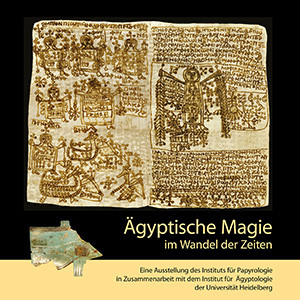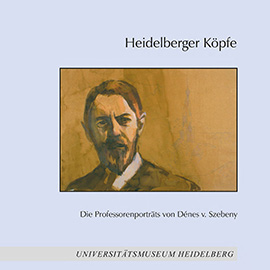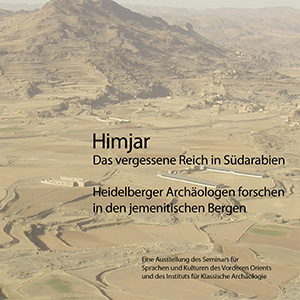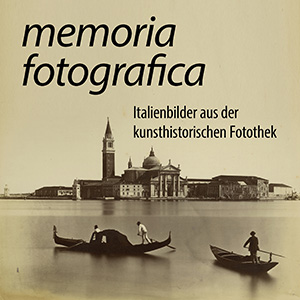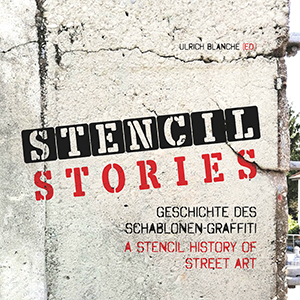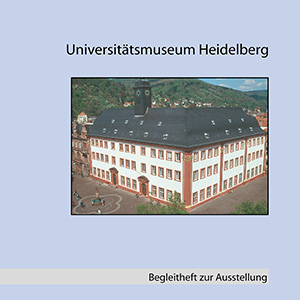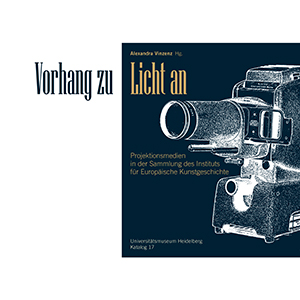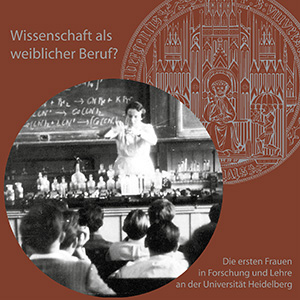Universitätsmuseum Heidelberg
Kataloge
Das Universitätsmuseum ist das "Schaufenster der Universität": Neben Einblicken in aktuelle Forschungen an der Ruperto Carola - von Affen bis Zellteilung - bieten die Ausstellungen auch Ergebnisse von Lehrveranstaltungen und Beiträge bürgerschaftlicher Gruppen zu universitären Themen. Vielfach dokumentieren Begleitbände diese Studioausstellungen; sie erscheinen in der Reihe "Universitätsmuseum Heidelberg. Kataloge". Ursprünglich als "Ausstellung zum Mitnehmen" für das Ausstellungspublikum konzipiert, sind die Kataloge dank der Online-Publikation nun weiten Kreisen zugänglich. Konzentriert und übersichtlich bieten sie Fachleuten, die nach selten publizierten Objekten und Archivalien suchen, ebenso spannende Lektüre wie Laien, die sich einen schnellen Überblick über ein ungewöhnliches Thema verschaffen möchten.

Herausgeber
Matthias Untermann
Kontakt
Universitätsmuseum
Grabengasse 1
D-69117 Heidelberg
Charlotte Lagemann
Tel.: +49 06221 54 3547
E-Mail: museum@rektorat.uni-heidelberg.de
Bisher erschienen
Ägyptische Magie im Wandel der Zeiten: Eine Ausstellung des Instituts für Papyrologie in Zusammenarbeit mit dem Institut für Ägyptologie der Universität Heidelberg
Das Institut für Papyrologie der Universität Heidelberg kann sich rühmen, in seiner Sammlung eines der bedeutendsten Corpora magischer Papyri weltweit zu besitzen. Die kleine, aber feine Gruppe von Pergamenten in koptischer Sprache, die wohl um die Jahrtausendwende entstanden und häufig mit Zeichnungen ausgestattet sind, wurde zusammen mit der in einem Papiercodex erhaltenen Kyprianlegende bereits 1934 in dem von Adolf Grohmann und Friedrich Bilabel herausgegebenen Band “Griechische, koptische und arabische Texte zur Religion und religiösen Literatur in Ägyptens Spätzeit” vorgelegt. Darin wurde auch der “soeben geglückte Erwerb” zweier einzigartiger Zauberbücher vermeldet, von denen das eine seit 1945 jedoch als verschollen galt. Einer der renommiertesten Forscher auf diesem Gebiet, P. Angelicus Kropp, konnte den Text aufgrund einer früheren Abschrift immerhin noch im Jahr 1966 publizieren, doch schien P. Heid. Kopt. inv. 686 (zuvor P. Heid. inv. 1686) für immer verloren.
Art the Ape of Nature: Eine Ausstellung zeitgenössischer Kunst
„Art the Ape of Nature – das Affenmotiv in der zeitgenössischen Kunst“ war Titel eines Mittelseminars am Institut für Europäische Kunstgeschichte in Heidelberg, dessen Ergebnis in der Schau „Art the Ape of Nature – Eine Ausstellung zeitgenössischer Kunst“ im Universitätsmuseum in Heidelberg 2013 zu sehen war. Im Seminar „Art the Ape of Nature – das Affenmotiv in der zeitgenössischen Kunst“ wurden in jeder Sitzung namhafte Vertreter der Neuesten Kunstgeschichte hinsichtlich ihres Umgangs mit dem Motiv des Affen diskutiert. Darunter waren der britische Nachkriegsmaler Francis Bacon, die politaktivistische Schriftfotografin Barbara Kruger, der Readymade-Kitschkünstler Jeff Koons, der expressive „Maleraffe“ Jörg Immendorff, die feministischen Aktions- und Plakatkünstlerinnen Guerilla Girls oder der Street „Artivist“ Banksy. Zudem wurde die Rolle etwa von Gorillas, Schimpansen und Pavianen in Darwin-Karikaturen des 19. Jahrhunderts sowie in heutigen Evolutionskarikaturen oder in Musikvideos von Bloodhound Gang, Peter Fox oder Modeselektor untersucht. Auch dem Darwinisten und Spiritisten Gabriel von Max, der exotischen Affenmalerei des „Naiven“ Henri Rousseau oder dem Dadaisten Francis Picabia wurde je eine Sitzung gewidmet, wie dem weniger bekannten Bildhauer Hugo Reinhold (gestorben 1900) oder dem Young British Artist Angus Fairhurst.
Für die Ausstellung konnten wir Künstler aus London, München und Wien gewinnen, die nicht nur wie Anja Priska oder Gerd Dengler Werke für unsere Ausstellung zur Verfügung stellten, sondern sich wie Larissa Kopp, Eva Blanché und Florian Aschka anlässlich „Art the Ape of Nature“ mit dem Motiv des Affen auseinandersetzten und neue Arbeiten explizit für die Ausstellung schufen.
Artefakte früher Mainzer Schriftkultur
Die markante frühmittelalterliche Überlieferung von Mainz bietet trotz hoher Verluste genügend Material, um alte Quantität und Qualität zu erkennen. Ausgehend von ihren Überresten, den Authentiken, hatte das Teilprojekt A08 am SFB 933 «Materiale Textkulturen» die Idee einer kleinen Ausstellung. Das Vorhaben hat Unterstützung durch das Dommuseum erfahren und ist zur Sonderausstellung «In Gold geschrieben» angewachsen, zu der ein umfangreicher Katalog erschienen ist. Auf Grundlage der dortigen Beiträge dokumentiert dieses Themenheft Artefaktbeschreibungen, die Materialien bis zur späten Karolingerzeit betreffen. Die Auswahl bietet einen virtuellen Rundgang durch die frühe Mainzer Schriftkultur.
Ausgezeichnet! Heidelberg und seine Nobelpreisträger. Begleitbroschüre zur Ausstellung im Universitätsmuseum Heidelberg
Die Vergabe der Nobelpreise in den Bereichen Physik, Chemie, Medizin, Literatur, Wirtschaft und Frieden wird alljährlich mit großer Spannung erwartet. Oft bieten die Entscheidungen der Nobelpreis-Jury Anlass zu emotionalen Debatten. Der Nobelpreis ist mehr als nur ein Wissenschaftspreis. Er ist die begehrteste Auszeichnung überhaupt. Wissenschaftler, denen der schwedische König im Rahmen einer prunkvollen und weltweit beachteten Nobelpreiszeremonie Medaille und Diplom überreicht, gelten als die herausragenden Vertreter ihrer Disziplin. In der Geistes- und Wissenschaftsgeschichte erlangen die Preisträger Unsterblichkeit.
Castrum Virtuale: Rekonstruktion eines spätantiken Fundorts am Plattensee. Eine Ausstellung in Gedenken an Prof. Géza Alföldy
Im vierten Jahrhundert nach Christus wurde auf dem Boden der römischen Provinz Pannonien in Keszthely-Fenékpuszta eine 15 ha große Festung errichtet. Die bisherigen archäologischen Untersuchungen am Westufer des Plattensees haben Wehr- und Monumentalbauten sowie zahlreiche Gräber aufgedeckt. Sie bieten Einblicke in die über 300 Jahre fortdauernde Besiedlungsgeschichte dieses Platzes.
Im Begleitheft zur Ausstellung werden die Ergebnisse der 2009 begonnenen deutsch-ungarischen Ausgrabungen vorgestellt. Ein besonderer Schwerpunkt liegt auf den Möglichkeiten der Visualisierung der untersuchten Bauten in Form von 3D-Rekonstruktionen, Lebensbildern und Modellen.
Christen und Muslime am Nil: Zusammenleben im früharabischen Ägypten. Begleitheft zur Ausstellung im Universitätsmuseum Heidelberg vom 28. April bis 16. Juli 2017
Mit der arabischen Eroberung Ägyptens änderte sich zunächst wenig für die einheimische Bevölkerung.
Die Ausstellung "Christen und Muslime am Nil" (28. April - 16. Juli 2017) im Universitätsmuseum Heidelberg zeigte anhand griechischer, koptischer und arabischer Papyri und archäologischer Objekte Veränderungen und Kontinuitäten innerhalb der früharabischen Zeit Ägyptens im Vergleich zur ausgehenden byzantinischen Epoche. Untersucht wurden unter anderem Gemeinsamkeiten und Unterschiede bei Glaube und Jenseitsvorstellungen, das Alltagsleben mit seinen Aspekten Ernährung und Kleidung sowie Veränderungen in den Verwaltungsstrukturen.
Heidelberger Köpfe: Die Professorenporträts von Dénes v. Szebeny
Aus Anlass des Heidelberger Universitätsjubiläums 1986 hat der Künstler und Grafiker Dénes v. Szebeny, aus Ungarn stammend und seit 1973 in Heidelberg ansässig, einen umfangreichen zeichnerischen Zyklus von Professorenporträts dieser Universität geschaffen. Der Schwerpunkt dieser Reihe liegt im 19. und frühen 20. Jahrhundert, der Rechtsphilosoph Samuel von Pufendorf (1661–1668) und der Physiker Walther Bothe (1932–1957) bilden die äußeren Exponenten.
Himjar: Das vergessene Reich in Südarabien
Vor gut drei Jahrzehnten präsentierte eine kleine Ausstellung des Römisch-Germanischen Zentralmuseums in Mainz die Ergebnisse mehrjähriger Restaurierungsarbeit an den Überresten von zwei – wie sich dabei herausstellte – fast zweieinhalb Meter hohen Königsfiguren, die im klassischen Kontrapost wie Heroenstatuen dargestellt waren, signiert von einem griechischen Künstler Phokas. Schlagartig stellte sich damit ein bis dahin den meisten Archäologen und Historikern noch völlig unbekanntes altsüdarabisches Königreich im heutigen Jemen vor – und versank danach wieder weitgehend in Vergessenheit.
Leben Dinge Texte: Begleitheft zur Ausstellung des Sonderforschungsbereichs 933 „Materiale Textkulturen“
Die Ausstellung „LEBEN DINGE TEXTE“ stellt Dinge vor, auf denen etwas geschrieben steht. Die Exponate stammen aus Gesellschaften vor der Erfindung des Buchdrucks: Keilschrifttafeln aus Mesopotamien, antike Graffiti, magische Papyrus-Amulette, gestempelte Dachziegeln, eine Hundeleine mit Edelstein-Inschrift - an solchen 'schrifttragenden Artefakten' kann untersucht werden, wie sich Beschreibstoffe auf die Bedeutung der Texte auswirken und umgekehrt. Außerdem zeigt sich, wie Schrift nicht nur gelesen wird, sondern vielfältig mit Handlungen verbunden und in Rituale eingebettet war.
Der Sonderforschungsbereich 933 „Materiale Textkulturen“ zeigt in dieser Ausstellung Zwischenergebnisse seiner Arbeit. Der SFB 933 wird von der Deutschen Forschungsgemeinschaft gefördert und vereint über 50 Wissenschaftlerinnen und Wissenschaftler der Ruprecht-Karls-Universität Heidelberg und der Hochschule für Jüdische Studien Heidelberg.
Licht! Lampen von der Antike bis zur Neuzeit. Begleitheft zur Ausstellung
Eine ungewöhnlich große Zahl von römischen Lampen ist in einem der größten bisher in Süddeutschland ergrabenen römischen Friedhöfe in Heidelberg zutage getreten und wird gerade von Andreas Hensen publiziert. Wie er feststellte, hat den Ausdruck „Lychnologie“ für die Lampenforschung vor fast zwei Jahrhunderten der Heidelberger Professor für Klassische Philologie und Archäologe Friedrich Creuzer geprägt. So ist es durchaus passend, dass die Internationale Lychnologie-Gesellschaft (ILA) ihren dritten internationalen Kongress im September 2009 in Heidelberg, der Geburtsstadt der Lychnologie, veranstaltet. Aus diesem Anlass haben wir in interdisziplinärer Zusammenarbeit von klassischer, provinzialrömischer und mittelalterlicher Archäologie in einem Seminar im Wintersemester 2008/09 diese kleine Ausstellung vorbereitet.
memoria fotografica: Italienbilder aus der kunsthistorischen Fotothek
Die Ausstellung memoria fotografica. Italienbilder aus der kunsthistorischen Fotothek dokumentiert erstmals einen Ausschnitt des insgesamt rund 75000 Aufnahmen von unter anderem Architektur, Malerei, Zeichnung und Skulptur umfassenden Fototheksbestandes am Institut für Europäische Kunstgeschichte (IEK) an der Universität Heidelberg. Der Bestand „Topographie Italien“ ist hierbei der umfangreichste und beinhaltet qualitätsvolle Aufnahmen von bekannten Fotografen, wie den Brüdern Alinari, Carlo Naya, Giorgio Sommer und James Anderson, sowie unterschiedliche Techniken, wie Albumin- und Gelatinesilberabzüge.
Religion in Ex-Position: Eine religionswissenschaftliche Ausstellung
Der vorliegende Begleitband entstand im Kontext der Ausstellung Religion in Ex-Position (2014/2015) als Kooperation des Instituts für Religionswissenschaft und des Universitätsmuseums der Universität Heidelberg. Neben einem Katalogteil, der die Ausstellung vorstellt und zum Betrachten und ‚Nachmachen‘ anregen soll, nimmt ein ergänzender Essayteil die gesamte Ausstellung sowie einzelne Exponate und Installationen in den Blick. Die Leitfrage „Wie können wir Religion(en) untersuchen?“ lädt dazu ein, religionswissenschaftliche Konzepte kennenzulernen, neue Perspektiven einzunehmen und Ansichten zu hinterfragen. Vorgestellt werden Ansätze führender Religionswissenschaftler_innen, Schwierigkeiten der Religionsdefinition sowie unterschiedliche Blickwinkel auf den Gegenstandsbereich ‚Religion‘. Beispiele aus dem Ausstellungskontext geben vertiefende Einblicke in die Konzepte rezenter Religionsforschung. Das Spektrum reicht von international renommierten Religionswissenschaftler_innen, Dozierenden und wissenschaftlichen Mitarbeiter_innen bis zu an der Ausstellung beteiligten Studierenden. Auch ‚fachfremde‘ Autor_innen kommen zu Wort.
Die Ausstellung Religion in Ex-Position war ein religionswissenschaftliches Lehrprojekt, welches anhand unterschiedlicher thematischer Schwerpunkte und praktischer Beispiele Arbeitsweisen kulturwissenschaftlicher Religionsforschung zeigte. Praxisnah und ‚zum Anfassen‘ wurden Theorien, Methoden und Konzepte der im frühen 20. Jahrhundert gegründeten ‚jungen‘ Disziplin Religionswissenschaft vorgestellt. Der Begleitband illustriert, wie vielfältig und gesellschaftsrelevant Religionsforschung sein kann.
Stencil Stories: A Stencil History of Street Art / Geschichte des Schablonen-Graffiti
Banksy ist heute einer der bekanntesten Künstler. Die Ursprünge seiner bevorzugten Technik, des Schablonengraffiti, blieben bislang weitgehend unerforscht. Ihrer Geschichte widmet sich „Stencil Stories“. Beginnend 1870, wird eine Linie von Gebrauchsschablonen über Propaganda- und Widerstandsschablonen vor 1945, Protestschablonen des Mai 1968, Künstlerschablonen der Pop Art und Konzeptkunst, Schablonen des Punk und der Pochoiristen bis hin zu Street-Art-Schablonen und Banksy gezogen. Behandelt werden u. a. Blek Le Rat, John Fekner, David Wojnarowicz, Vhils, Alex Vallauri, C215, Banksy oder Punkbands wie CRASS und The Clash. Studierende der Universität und der PH Heidelberg steuerten Texte bei.
Universitätsmuseum Heidelberg: Begleitheft zur Ausstellung
Der Katalog ist das Begleitheft zur Dauerausstellung des Heidelberger Universitätsmuseums, so wie sie im Jahr 2006 dem Publikum präsentiert wurde. Das Universitätsmuseum ist seit 1996 im barocken Bau der „Alten Universität“ untergebracht. Während sich das eigentliche Museum im Erdgeschoss des 1712 erbauten Gebäudes befindet, sind im ersten Obergeschoss die Alte Aula und im Nebengebäude der Studentenkarzer zu finden – beides Zeugnisse der traditionsreichen Universitätsgeschichte.
Beschrieben werden die Exponate in den drei Räumen des Museums, die sich mit der Geschichte Universität von der Gründung 1386 bis zum Jubiläum 1786 (Raum A), der Universität im 18. und 19. Jahrhundert (Raum B) sowie der Universität im 20. Jahrhundert (Raum C) beschäftigen. Außerdem enthält der Katalog Informationen zu der "Alten Aula" und zum Karzer.
Vorhang zu – Licht an: Projektionsmedien in der Sammlung des Instituts für Europäische Kunstgeschichte
Kunsthistorische Lehre ist ohne Bilder nicht denkbar. Während im 19. Jahrhundert noch Reproduktionen auf Papier durch die Reihen der Zuhörer:innen gereicht wurden, ermöglichten ab etwa 1900 Lichtbilder auf der (Lein-)Wand das gemeinsame, zeitgleiche Betrachten. Für die Kunstgeschichte wird der parallele Einsatz von zwei Projektoren prägend: Das vergleichende Sehen etablierte sich als zentrale Lehrmethode.
Im Rahmen einer Lehrveranstaltung am Institut für Europäische Kunstgeschichte (Wintersemester 2022/23, Leitung Dr. Alexandra Vinzenz) beschäftigten sich Studierende mit den bildgebenden Geräten in der institutseigenen Sammlung. Vom Epidiaskop über Diaprojektoren seit den 1910er Jahren bis hin zum 16mm-Filmprojektor ist in der Ausstellung und im Katalog ein repräsentativer Querschnitt zu sehen.
Wissenschaft als weiblicher Beruf? Die ersten Frauen in Forschung und Lehre an der Universität Heidelberg
Die Entwicklungslinien der neueren Forschung zur Geschichte der Universitäten in Deutschland wurden in den letzten zwei Jahrzehnten stark von der (akademischen) Kultur- und Sozialgeschichte sowie Gender-Fragen beeinflusst. So liegen inzwischen Einzelstudien und einige übergreifende Vergleiche zu den Qualifizierungsformen der Promotion und Habilitation als „spezifisch deutschem Weg“ neben den geschlechterspezifischen Zugangsmöglichkeiten zu Studium und wissenschaftlicher Kariere vor. Für die Universität Heidelberg fehlte bisher allerdings eine breite Untersuchung zu den ersten Frauen in Forschung und Lehre in diesem Kontext. Der vorliegende Band, den eine kleine Gruppe von Studierenden der Geschichte in einem Projekt erarbeitet hat, möchte diese Lücke schließen.

